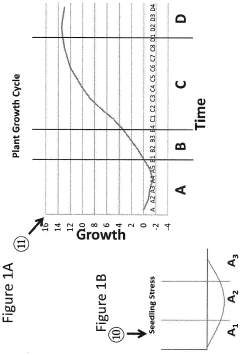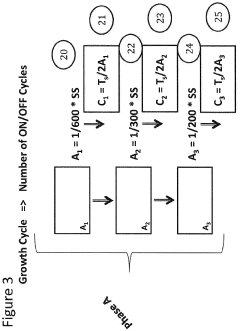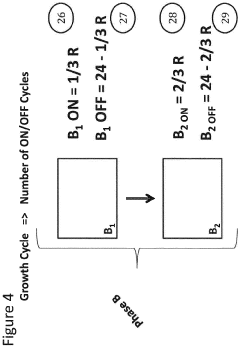How to Analyze Hypertonic Solutions' Impact on Plant Growth?
Hypertonic Solutions and Plant Growth Research Objectives
The study of hypertonic solutions' impact on plant growth has gained significant attention in recent years, driven by the need to understand and optimize plant responses to environmental stresses. This research aims to elucidate the complex interactions between hypertonic solutions and plant physiology, with the ultimate goal of enhancing crop productivity and resilience in challenging environments.
The primary objective of this research is to develop a comprehensive analytical framework for assessing the effects of hypertonic solutions on various aspects of plant growth and development. This includes investigating changes in cellular structure, metabolic processes, and overall plant performance when exposed to high solute concentrations. By systematically examining these factors, researchers seek to identify key mechanisms that govern plant responses to osmotic stress.
Another crucial aim is to establish standardized methodologies for quantifying and comparing the impacts of different hypertonic solutions across diverse plant species and growth stages. This standardization will facilitate more accurate and reproducible experiments, enabling researchers to draw meaningful conclusions from their studies and compare results across different research groups.
Furthermore, this research endeavors to explore the potential applications of controlled hypertonic stress in agricultural practices. By understanding how plants adapt to and potentially benefit from exposure to hypertonic environments, scientists can develop innovative strategies for improving crop tolerance to drought, salinity, and other osmotic stresses. This knowledge could lead to the development of more resilient crop varieties and more efficient irrigation techniques.
The research also aims to investigate the molecular and genetic basis of plant responses to hypertonic conditions. By identifying genes and signaling pathways involved in osmotic stress tolerance, researchers can pave the way for targeted genetic modifications to enhance plant resilience. This genetic approach could revolutionize crop breeding programs and contribute to the development of plants better suited to challenging environmental conditions.
Additionally, this research seeks to elucidate the long-term effects of hypertonic stress on plant growth and reproduction. By examining multi-generational impacts, scientists can gain insights into the evolutionary adaptations of plants to osmotic stress and assess the potential ecological consequences of prolonged exposure to hypertonic environments.
Lastly, an important objective is to develop predictive models that can simulate plant responses to various hypertonic conditions. These models would integrate data from multiple experiments and environmental factors, allowing researchers to forecast plant behavior under different scenarios and optimize growth conditions in controlled environments.
Market Demand for Hypertonic Solution Applications
The market demand for hypertonic solution applications in plant growth analysis has been steadily increasing in recent years. This growth is primarily driven by the agricultural sector's need for more efficient and sustainable farming practices. Hypertonic solutions play a crucial role in understanding plant stress responses, particularly in relation to drought and salinity tolerance.
In the agricultural industry, there is a growing interest in developing crops that can withstand harsh environmental conditions. This has led to an increased demand for research tools and methodologies that can accurately assess plant responses to hypertonic stress. Farmers and agronomists are seeking ways to optimize crop yields in areas with limited water resources or high soil salinity, making hypertonic solution applications valuable for both research and practical field applications.
The biotechnology and seed development sectors have also shown significant interest in hypertonic solution applications. These industries require precise methods to evaluate new plant varieties and genetically modified organisms for their ability to thrive under osmotic stress conditions. The market for specialized equipment and reagents used in hypertonic solution experiments has expanded, catering to both academic research institutions and commercial laboratories.
Environmental monitoring and conservation efforts have further contributed to the market demand. As climate change continues to affect global ecosystems, there is an increasing need to understand how native plant species respond to changing osmotic conditions in their habitats. This has created opportunities for companies providing hypertonic solution-based analysis tools and services in ecological research and restoration projects.
The pharmaceutical and nutraceutical industries have also recognized the potential of hypertonic solution applications in studying medicinal plants. These sectors are investing in research to understand how osmotic stress affects the production of bioactive compounds in plants, potentially leading to new drug discoveries or improved cultivation methods for medicinal herbs.
In the horticulture and landscaping industries, there is a growing demand for plants that can thrive in challenging urban environments. Hypertonic solution applications are being used to develop and select plant varieties that are more resilient to the stresses of city life, such as pollution and limited water availability. This has opened up new market opportunities for nurseries and landscape designers specializing in stress-resistant plants.
The market for hypertonic solution applications extends beyond direct plant growth analysis. There is an increasing demand for educational tools and kits that demonstrate osmosis and plant physiology concepts in schools and universities. This educational market segment has shown steady growth as STEM education initiatives emphasize hands-on learning experiences.
Current Challenges in Hypertonic Solution Studies
The study of hypertonic solutions' impact on plant growth faces several significant challenges that hinder comprehensive understanding and practical application. One primary obstacle is the complexity of plant responses to osmotic stress induced by hypertonic environments. Plants exhibit diverse adaptive mechanisms at cellular, tissue, and whole-plant levels, making it difficult to isolate and quantify specific effects of hypertonic solutions.
Standardization of experimental protocols presents another major challenge. Variations in plant species, growth stages, solution concentrations, and exposure durations can lead to inconsistent results across studies. This lack of uniformity complicates the comparison and integration of findings from different research groups, impeding the development of a cohesive understanding of hypertonic solution effects.
The dynamic nature of plant-environment interactions further complicates analysis. Hypertonic solutions can trigger cascading physiological responses that evolve over time, necessitating sophisticated temporal monitoring techniques. Current methodologies often struggle to capture these complex, time-dependent changes accurately, particularly at the molecular and cellular levels.
Another significant challenge lies in distinguishing between the direct effects of hypertonic solutions and secondary stress responses. Hypertonic conditions can induce various forms of abiotic stress, including oxidative and ionic imbalances. Separating these interrelated effects to identify causal relationships remains a formidable task for researchers in the field.
The translation of laboratory findings to real-world agricultural applications poses yet another hurdle. Controlled experimental conditions often fail to account for the multitude of environmental variables present in natural or agricultural settings. This gap between laboratory observations and field performance limits the practical applicability of research findings.
Additionally, the long-term effects of hypertonic solutions on plant growth and development are not well understood. Most studies focus on short-term responses, leaving questions about chronic exposure and multigenerational impacts largely unanswered. This knowledge gap is particularly relevant for assessing the sustainability of agricultural practices involving hypertonic treatments.
Lastly, the molecular mechanisms underlying plant tolerance to hypertonic stress remain incompletely elucidated. While progress has been made in identifying key genes and signaling pathways involved in osmotic stress responses, a comprehensive understanding of their regulation and interaction is still lacking. This limitation hampers efforts to develop targeted strategies for enhancing plant resilience to hypertonic conditions.
Existing Methodologies for Hypertonic Solution Analysis
01 Effect of hypertonic solutions on plant growth
Hypertonic solutions can influence plant growth by affecting water uptake and cellular processes. These solutions have a higher solute concentration than the plant cells, which can lead to water loss from plant tissues. This osmotic stress can impact various aspects of plant development, including root growth, seed germination, and overall plant vigor.- Effect of hypertonic solutions on plant growth: Hypertonic solutions can influence plant growth by affecting water uptake and cellular processes. These solutions have a higher solute concentration than the plant cells, which can lead to water loss from the plant tissues. This osmotic stress can impact various aspects of plant development, including root growth, leaf expansion, and overall plant vigor.
- Use of hypertonic solutions in plant tissue culture: Hypertonic solutions are utilized in plant tissue culture techniques to control cell growth and differentiation. By manipulating the osmotic environment, researchers can induce specific responses in plant cells, such as somatic embryogenesis or organogenesis. This approach is valuable for plant propagation and genetic improvement in agricultural and horticultural applications.
- Hypertonic solutions for seed priming and germination: Hypertonic solutions are employed in seed priming techniques to enhance germination rates and seedling vigor. By exposing seeds to controlled osmotic stress, the priming process can activate physiological and biochemical changes that improve seed performance. This method is particularly useful for improving crop establishment in challenging environmental conditions.
- Hypertonic solutions in plant stress tolerance: Research explores the use of hypertonic solutions to induce stress tolerance in plants. Controlled exposure to osmotic stress can trigger adaptive responses, leading to improved tolerance to various environmental stresses such as drought, salinity, and temperature extremes. This approach has potential applications in developing more resilient crop varieties.
- Hypertonic solutions for post-harvest preservation: Hypertonic solutions are utilized in post-harvest treatments to extend the shelf life of fruits and vegetables. By creating an osmotic gradient, these solutions can help reduce water loss, maintain tissue firmness, and slow down senescence processes. This technique is valuable for improving the quality and storage duration of harvested plant products.
02 Use of hypertonic solutions in plant stress tolerance
Hypertonic solutions can be utilized to enhance plant stress tolerance. By exposing plants to controlled levels of osmotic stress, it is possible to induce adaptive responses that improve their resilience to environmental challenges such as drought, salinity, and temperature extremes. This approach can be applied in agricultural practices to develop more robust crop varieties.Expand Specific Solutions03 Hypertonic solutions in plant tissue culture
In plant tissue culture, hypertonic solutions play a crucial role in various techniques such as protoplast isolation, cell fusion, and cryopreservation. These solutions can be used to manipulate osmotic pressure, facilitating the extraction of cellular components or the preservation of plant tissues for long-term storage and research purposes.Expand Specific Solutions04 Hypertonic solutions for seed priming
Seed priming using hypertonic solutions is a technique employed to enhance seed performance and germination. By exposing seeds to controlled osmotic stress, it is possible to initiate metabolic processes that prepare the seed for rapid and uniform germination upon planting. This method can improve seedling vigor and overall plant establishment in various crop species.Expand Specific Solutions05 Hypertonic solutions in plant nutrient delivery
Hypertonic solutions can be utilized in specialized nutrient delivery systems for plants. By carefully formulating nutrient solutions with higher osmotic potential, it is possible to enhance the uptake of specific minerals or growth-promoting compounds. This approach can be particularly useful in hydroponic systems or in the development of foliar sprays for targeted nutrient application.Expand Specific Solutions
Key Players in Plant Physiology Research
The analysis of hypertonic solutions' impact on plant growth is currently in a growth phase, with increasing market size and technological advancements. The global plant growth regulators market, which includes hypertonic solutions, is expected to expand significantly in the coming years. Companies like Valent BioSciences Corp., Sumitomo Chemical Co., Ltd., and Syngenta Participations AG are at the forefront of this research, demonstrating varying levels of technological maturity. Academic institutions such as Tianjin Normal University and Sichuan University are also contributing to the field, indicating a collaborative approach between industry and academia. The technology's maturity ranges from early-stage research to commercially available products, with companies like Bayer CropScience and Corteva Agriscience leading in practical applications.
Valent BioSciences Corp.
Sumitomo Chemical Co., Ltd.
Innovative Techniques in Plant Stress Response Studies
- A closed environment hydroponics system that optimizes nutrient solution composition, pH calibration, temperature control, lighting, and carbon dioxide delivery based on plant growth stages, utilizing a combination of LED lighting, carbon dioxide tubing for enrichment, and electroculture to stimulate plant growth, while recapturing oxygen to improve nutrient oxygenation.
- A hydroponic method and culture solution with adjusted magnesium and nitrate concentrations, ranging from 24 ppm to 120 ppm for magnesium and 4 to 50 ppm for nitrate nitrogen during the seedling-raising period, and 48 ppm to 120 ppm for magnesium and 150 ppm to 200 ppm for nitrate nitrogen during the growing period, to promote growth and shorten the cultivation period by 30 to 50%.
Environmental Factors Affecting Hypertonic Solution Impact
Environmental factors play a crucial role in determining the impact of hypertonic solutions on plant growth. Temperature is one of the most significant factors influencing this interaction. Higher temperatures generally increase the rate of osmosis, potentially exacerbating the effects of hypertonic solutions on plant cells. Conversely, lower temperatures may slow down the osmotic process, potentially mitigating some of the negative impacts of hypertonic environments on plant growth.
Light intensity and duration also significantly affect how plants respond to hypertonic conditions. Increased light exposure can enhance photosynthesis, potentially helping plants to better cope with osmotic stress. However, excessive light in combination with hypertonic conditions may lead to increased water loss through transpiration, further stressing the plant.
Humidity levels in the surrounding environment can modulate the effects of hypertonic solutions. In high humidity conditions, the rate of water loss from plant tissues may be reduced, potentially lessening the impact of hypertonic solutions. Conversely, low humidity can exacerbate water loss, compounding the stress caused by hypertonic environments.
Soil composition and structure are also critical factors. The presence of certain minerals or organic matter in the soil can influence how hypertonic solutions interact with plant roots. Well-structured soils with good water retention properties may help buffer the effects of hypertonic solutions, while poor soil structure can exacerbate their impact.
Atmospheric CO2 levels can indirectly influence plant responses to hypertonic conditions. Elevated CO2 concentrations may lead to increased water use efficiency in some plants, potentially helping them cope better with osmotic stress. However, the relationship between CO2 levels and plant responses to hypertonic solutions is complex and species-dependent.
Wind exposure is another environmental factor to consider. Increased wind can lead to higher rates of transpiration, potentially intensifying the effects of hypertonic solutions on plant water status. Plants in windy environments may therefore be more susceptible to damage from hypertonic conditions.
Lastly, the presence of other environmental stressors, such as air pollutants or pathogens, can interact with hypertonic stress to produce compound effects on plant growth. These interactions can be synergistic, where the combined effect is greater than the sum of individual stressors, or antagonistic, where one stress partially mitigates the effects of another.
Ethical Considerations in Plant Experimentation
When conducting experiments on plant growth using hypertonic solutions, it is crucial to consider the ethical implications of such research. The use of plants in scientific studies raises important questions about the responsible treatment of living organisms and the potential environmental impact of experimental procedures.
One primary ethical consideration is the welfare of the plants themselves. While plants do not possess the same level of sentience as animals, they are still living organisms that can experience stress and harm. Researchers must ensure that experimental protocols minimize unnecessary suffering or damage to the plants. This includes providing appropriate care, such as adequate water, nutrients, and light, even when subjecting plants to hypertonic conditions.
The selection of plant species for experimentation also carries ethical weight. Researchers should prioritize the use of common, non-endangered species whenever possible. If rare or protected species are necessary for the study, proper permits and justifications must be obtained, and extra care taken to minimize the impact on wild populations.
Environmental concerns must be addressed when designing and conducting plant experiments. The disposal of hypertonic solutions and treated plant material should follow strict protocols to prevent contamination of soil or water systems. Additionally, researchers must consider the potential for unintended spread of genetically modified or non-native plant species used in experiments.
Transparency and reproducibility are essential ethical components of scientific research. Detailed documentation of experimental methods, including the composition of hypertonic solutions and their application, should be maintained and made available to the scientific community. This ensures that other researchers can validate findings and build upon the work without unnecessarily repeating experiments on living plants.
The broader implications of the research should also be considered. While studying the effects of hypertonic solutions on plant growth may lead to valuable insights for agriculture or environmental science, researchers must be mindful of potential misuse of their findings. For instance, knowledge gained could be applied to develop herbicides or other products that may have negative ecological consequences if not properly regulated.
Lastly, researchers should engage in ongoing ethical reflection throughout the experimental process. This includes regular assessments of the necessity and value of each experiment, weighing the potential benefits against the ethical costs. Collaboration with ethicists and environmental scientists can provide valuable perspectives and help ensure that plant experimentation adheres to the highest ethical standards.







